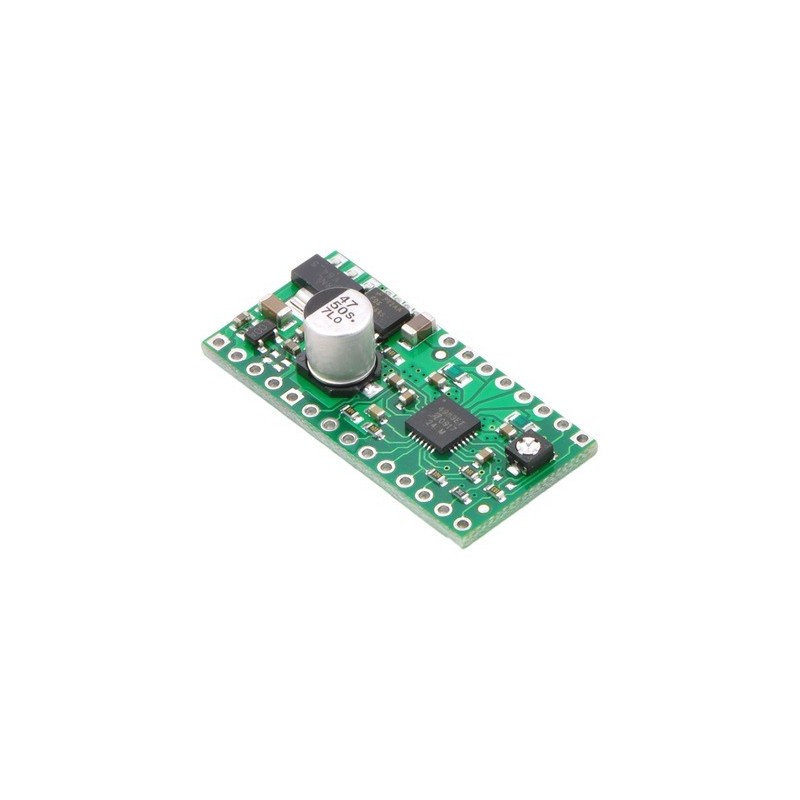



29,30 zł Netto
A4988 Stepper Motor Driver Carrier with Voltage Regulators umożliwia precyzyjne sterowanie silnikami krokowymi z wykorzystaniem mikrokroku i regulacji prądu. Moduł sprawdza się w aplikacjach wymagających dokładnego pozycjonowania oraz prostej integracji z popularnymi mikrokontrolerami. Pololu 1183
Pololu 1183 – A4988 Stepper Motor Driver Carrier with Voltage Regulators przeznaczony do sterowania bipolarnymi silnikami krokowymi w projektach robotycznych, automatyce oraz systemach precyzyjnego pozycjonowania. Moduł oparty na układzie A4988 umożliwia realizację mikrokroku, co pozwala na płynniejszy ruch silnika, zmniejszenie drgań oraz poprawę dokładności pozycjonowania.
Zintegrowane stabilizatory napięcia umożliwiają bezpośrednie zasilanie części logicznej z wyższego napięcia, upraszczając integrację z mikrokontrolerami pracującymi z logiką 3,3 V lub 5 V. Regulowany ogranicznik prądu pozwala na dopasowanie parametrów pracy do konkretnego silnika, chroniąc go przed przeciążeniem. Moduł znajduje zastosowanie w drukarkach 3D, ploterach, frezarkach CNC, manipulatorach oraz projektach edukacyjnych.
Cechy
Producent BTC Korporacja sp. z o. o. Lwowska 5 05-120 Legionowo Polska sprzedaz@kamami.pl 22 767 36 20
Osoba odpowiedzialna BTC Korporacja sp. z o. o. Lwowska 5 05-120 Legionowo Polska sprzedaz@kamami.pl 22 767 36 20
Pololu Dual MC33926 Motor Driver Shield for Arduino
Moduł sterownika silnika krokowego STSPIN220 o niskim zakresie napięcia zasilania 1,8...10V i prądzie pracy 1,1A. Sterownik pozwala na kontrolowanie ruchu silnika aż z 9 różnymi rozdzielczościami (do 1/256 kroku). Pololu 2877
Moduł sterownika RC typu ESC dedykowany do silników szczotkowych DC o napięciu zasilania do od 4,2 V do 8,4 V i poborze prądu do 3 A
Tic T834 USB Multi-Interface Stepper Motor Controller to sterownik silnika krokowego oparty na układzie DRV8834. Pozwala sterować silnikiem krokowym który napięcie na cewkę wynosi 2,5....10,8V, natomiast maksymalny prąd na cewkę wynosi do 1,5A. Sterownikiem można sterować przy pomocy: USB, TTL, I2C, RC (PWM modelarski), wejście analogowe czy enkoder kwadraturowy. Pololu 3132
Brak towaru
Shield z dwukanałowym sterownikiem silników DC dla Arduino. Ma napięcie pracy od 7 do 30 V i prąd ciągły do 10 A. Może być sterowany sygnałem PWM lub za pomocą wbudowanych przycisków. Cytron SHIELD-MDD10
Pololu TReX Dual Motor Controller DMC01 umożliwia sterowanie dwoma silnikami DC o dużej mocy z wykorzystaniem różnych metod sterowania. Moduł sprawdza się w zaawansowanych projektach robotycznych, gdzie wymagane pozostają wysoka wydajność prądowa, elastyczna integracja oraz niezawodna praca układu napędowego. Pololu 777
Moduł ze sterownikiem silnika krokowego oparty na układzie DRV8434. Pozwala na zasilanie silnika bipolarnego prądem do 1,2 A na fazę i napięciem od 4,5 V do 48 V. Pololu 3762
Brak towaru
Miniaturowy sterownik ESC silnika bezszczotkowego 7A 1-2S BLheli_S XSD7A to kompaktowe urządzenie o dużej wydajności, idealne do kontroli silników bezszczotkowych w małych projektach. Dzięki niskiej wadze i solidnej mocy, nadaje się do dronów, modeli RC i innych aplikacji wymagających precyzyjnej kontroli silnika.
Sterownik silnika prądu stałego (DC) o napięciu pracy 6,5-30V i maksymalnym prądzie ciągłym 27A. Posiada możliwość łatwej realizacji pętli sprzężenia zwrotnego oraz liczne interfejsy sterujące. Pololu 3148
Brak towaru
Sterownik silnika DC zasilany napięciem w zakresie 1,8 do 10V o maksymalnym prądzie wyjściowym 2,6A. Kompatybilny z STM32 Nucleo. Shield wyposażony jest w złącze zgodne ze standardem Arduino UNO R3. STMicroelectronics X-NUCLEO-IHM13A1
Sterownik silnika krokowego do precyzyjnego sterowania silnikami bipolarnymi, oferujący sześć trybów mikrokroku (od pełnego do 1/32). Pracuje w zakresie napięć 8,2 V do 44 V i dostarcza do 1,5 A na fazę bez chłodzenia lub do 2,2 A przy zastosowaniu radiatora/wentylatora, zapewniając płynną i stabilną pracę nawet przy wysokich prędkościach. Dzięki kompatybilności z popularnymi sterownikami A4988 i DRV8825, wbudowanemu regulatorowi oraz zabezpieczeniom przed przegrzaniem, przeciążeniem i zwarciem, TB67S581FNG jest niezawodnym i uniwersalnym rozwiązaniem do aplikacji wymagających precyzyjnego sterowania ruchem. Pololu 2988
Zestaw zawierający sterownik Ardumoto w postaci shielda dla Arduino, dwa silniki prądu stałego, wraz z pasującymi kołami, oraz niezbędne złącza. SparkFun KIT-14180
Brak towaru
Moduł z układem L298N umożliwiający niezależne sterowanie dwoma silnikami DC lub jednym silnikiem krokowym, idealny do robotyki i projektów DIY. Obsługuje zasilanie od 7 V do 35 V i posiada wbudowany stabilizator 5 V, który może zasilać dodatkowe układy. Sterowanie odbywa się za pomocą pinów ENA, ENB oraz IN1–IN4, co pozwala regulować kierunek obrotów i prędkość. Moduł wyposażono w diody zabezpieczające i kondensatory filtrujące, co zapewnia stabilną i niezawodną pracę.
Brak towaru
Zaawansowany sterownik silnika krokowego Nema 23 z serii CLRS, zaprojektowany do precyzyjnych zastosowań przemysłowych z komunikacją sieciową RS485 (Modbus RTU). Eliminuje ryzyko utraty kroków dzięki zamkniętej pętli sprzężenia zwrotnego i oferuje wsparcie dla trybów: pozycjonowania (Profile Position), prędkości (Velocity), powrotu do pozycji referencyjnej (Homing) oraz PR Mode z 16-pozycyjną tabelą sterowania punkt-do-punktu. Sterownik obsługuje do 31 osi w jednej sieci, oferuje prąd do 7 A, napięcie zasilania od 20 do 50 VDC i chłodzenie pasywne lub aktywne, co czyni go niezawodnym rozwiązaniem dla robotyki, automatyki i systemów CNC. CL2C-RS57
Płytka umożliwiająca jednoczesne sterowanie dwoma silnikami z pełną kontrolą kierunku i zatrzymania, idealna do robotycznych buggy i pojazdów edukacyjnych. Ma wbudowane zabezpieczenia przed zwarciem, przeciążeniem i przegrzaniem, a także stabilizowane wyjście 3 V zasilające micro:bit. Dzięki złączu Edge Connector i dodatkowym wyprowadzeniom można łatwo podłączać czujniki, przełączniki i akcesoria, rozszerzając funkcjonalność projektu. Programowanie wspierane jest przez dedykowane bloki MakeCode oraz obsługę w Pythonie Kitronik 5698
Sterownik silników pozwalający na sterowanie silnikiem krokowym o napięciu z zakresu 8-50V który pobiera maksymalny prąd do 4A (do 6 z dodatkowym chłodzeniem). Pololu 3141

A4988 Stepper Motor Driver Carrier with Voltage Regulators umożliwia precyzyjne sterowanie silnikami krokowymi z wykorzystaniem mikrokroku i regulacji prądu. Moduł sprawdza się w aplikacjach wymagających dokładnego pozycjonowania oraz prostej integracji z popularnymi mikrokontrolerami. Pololu 1183
